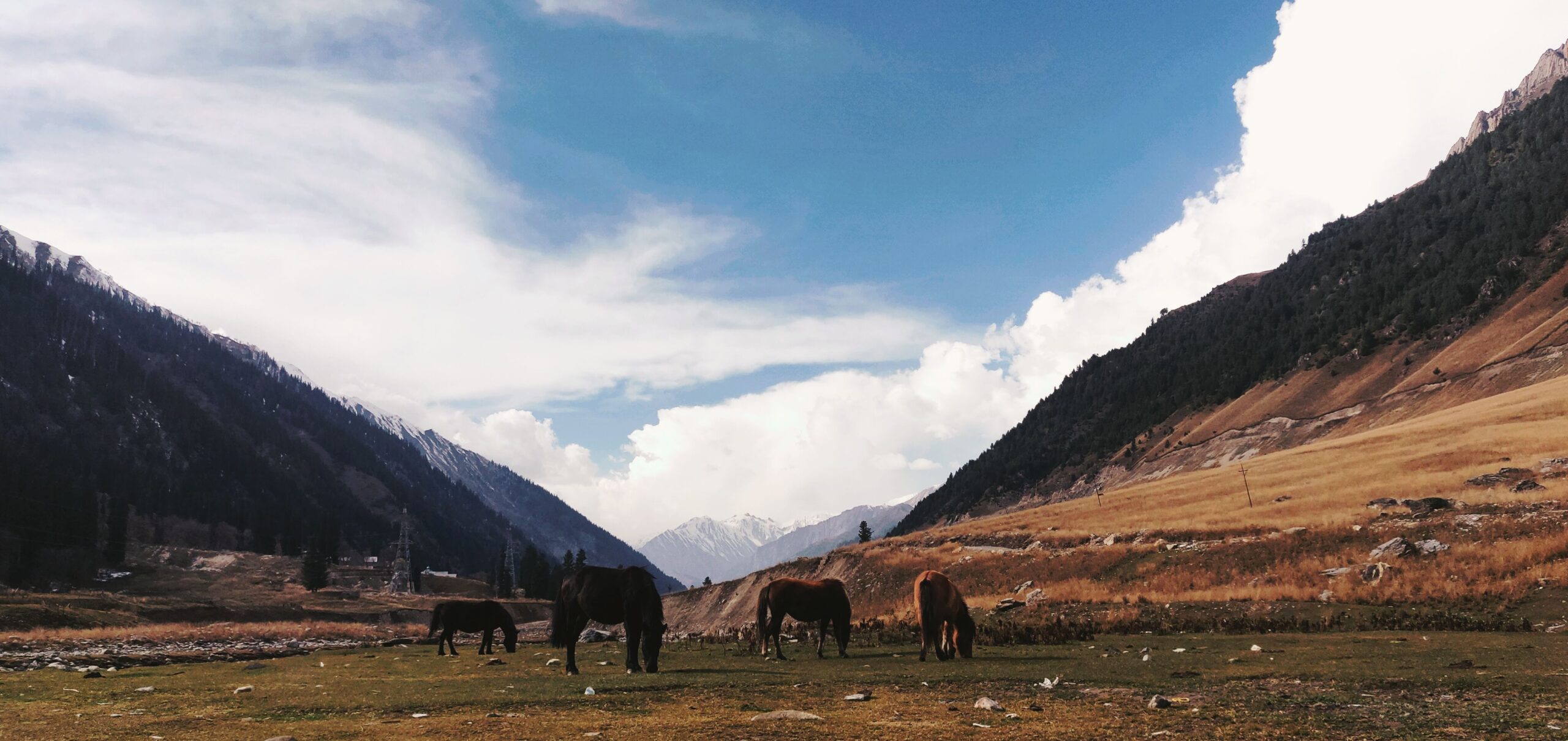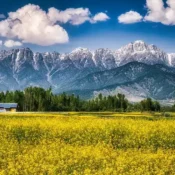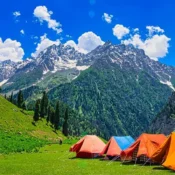
Kashmiri Wazwan: A Culinary Extravaganza from the Vale of Kashmir
Introduction
The Kashmiri Wazwan is a grand feast, a culinary tradition deeply ingrained in the rich cultural tapestry of the Kashmir Valley. This elaborate meal has a long and fascinating history, dating back centuries, and is celebrated for its delicious dishes, traditional cooking methods, and its role in Kashmiri culture and hospitality. In this comprehensive exploration, we delve into the historical context, the unique dishes that make up the Wazwan, and the cultural significance of this exceptional culinary tradition.
Historical Context of Kashmiri Wazwan
- Ancient Roots: The origins of the Kashmiri Wazwan can be traced back to the 14th century during the reign of Sultan Zain-ul-Abidin, also known as ‘Budshah.’ Under his patronage, the culinary culture of Kashmir underwent a significant transformation, giving rise to the concept of the Wazwan. It combined the Persian influence of the Mughal Empire with the indigenous culinary traditions of Kashmir.
- Persian Influence: The term ‘Wazwan’ itself is derived from the Persian word ‘Wazan,’ meaning “a balance” or “a weight.” This reflects the emphasis on balance and harmony in Kashmiri cuisine, both in terms of flavor and presentation.
- Royal Feasts: Originally, the Wazwan was a feast reserved for royal banquets and special occasions. It was prepared by master chefs known as ‘vasta waza’ who had undergone rigorous training in the art of Kashmiri cooking. Over time, it evolved into a communal celebration, enjoyed by families and communities during weddings, festivals, and other significant events.
The Components of Wazwan
The Kashmiri Wazwan is a multi-course meal characterized by a dazzling array of dishes, each with its own unique flavors and preparation methods. The core components of the Wazwan include:
- Rice: At the heart of the Wazwan is a generous serving of fragrant long-grain rice, typically served on a large platter called the ‘trami.’ The rice is meticulously prepared to be fluffy and aromatic.
- Rogan Josh: Perhaps the most famous dish of the Wazwan, Rogan Josh is a rich, aromatic lamb curry. The deep red color and the infusion of spices give this dish its distinctive flavor. It’s often considered the showstopper of the Wazwan.
- Gushtaba: This dish is a delicacy made from minced mutton balls cooked in a yogurt-based gravy. It’s known for its creamy texture and mild yet flavorful taste.
- Yakhni: Yakhni is a delicate yogurt-based mutton or chicken curry flavored with subtle spices like fennel and saffron. It’s known for its lightness and soothing qualities.
- Methi Maaz: Methi Maaz is a flavorful dish made with tender chunks of lamb cooked with dried fenugreek leaves. The bitterness of fenugreek adds a unique dimension to this preparation.
- Dum Aloo: Dum Aloo is a vegetarian delight featuring small potatoes cooked in a rich and spicy tomato-based gravy. It’s a popular choice among vegetarians and a delightful contrast to the meat-heavy Wazwan.
- Chaman: Chaman is a paneer (Indian cottage cheese) dish cooked in a rich tomato-based gravy. It’s a delightful option for vegetarians and adds a creamy texture to the meal.
- Marchwangan Korma: Marchwangan Korma is a spicy red chili-infused mutton curry that adds a fiery kick to the Wazwan. It’s a testament to the bold and diverse flavors of Kashmiri cuisine.
- Phirni: To conclude the Wazwan on a sweet note, Phirni is a creamy rice pudding flavored with cardamom and garnished with pistachios and almonds. It’s a dessert cherished for its comforting taste.
Preparation and Presentation
The preparation of a Wazwan is an intricate and time-consuming process. The vasta waza, or head chef, oversees the preparation and is assisted by a team of skilled cooks. The cooking methods involve slow-cooking, simmering, and roasting to bring out the complex flavors and textures of the dishes.
The presentation of the Wazwan is an art form in itself. The dishes are arranged on the trami (large platter) in a specific order, often following a traditional layout. The centerpiece is usually the Rogan Josh, surrounded by the other dishes. This arrangement reflects the balance and harmony that are integral to Kashmiri cuisine.
Cultural Significance of Kashmiri Wazwan
The Kashmiri Wazwan extends beyond being just a meal; it holds profound cultural significance:
- Symbol of Hospitality: In Kashmiri culture, hosting a Wazwan is considered the ultimate display of hospitality. It is a way of welcoming and honoring guests, emphasizing the warm and inclusive nature of Kashmiri society.
- Celebratory Events: The Wazwan is an integral part of all major celebrations, especially weddings. It symbolizes the joy and togetherness of the community.
- Preservation of Tradition: The Wazwan is a way of preserving and passing down Kashmiri culinary traditions from one generation to the next. The art of cooking these dishes is often a closely guarded family secret.
- Cultural Exchange: Over the centuries, the Wazwan has absorbed influences from various cultures, including Persian and Central Asian cuisines. It serves as a testament to Kashmir’s historical role as a crossroads of diverse civilizations.
- Community Bonding: The preparation and consumption of a Wazwan often involve the participation of the entire community, fostering a sense of unity and camaraderie.
Modern Adaptations and Challenges
In modern times, the Kashmiri Wazwan faces challenges due to changing lifestyles and dietary preferences. While it remains a cherished tradition, there is a need to adapt to evolving tastes and culinary practices. Some restaurants and caterers have begun offering mini-Wazwan packages to accommodate smaller gatherings and individual preferences.
Additionally, the political and social unrest in the region has affected the availability of certain ingredients and disrupted the traditional supply chain for some Wazwan dishes. Despite these challenges, the Wazwan continues to be a symbol of resilience and cultural pride for the people of Kashmir.
Conclusion
The Kashmiri Wazwan is a testament to the rich cultural heritage and culinary expertise of the Kashmiri people. Its historical roots, diverse dishes, and cultural significance make it a remarkable and cherished tradition. As the Wazwan continues to evolve and adapt, it remains a symbol of hospitality, community, and the enduring spirit of the Kashmir Valley. It stands not only as a culinary delight but also as a cultural treasure that continues to enrich the lives of those who partake in its sumptuous offerings.
FAQs (Frequently Asked Questions)
1. What is the significance of the term ‘Wazwan’?
- The term ‘Wazwan’ is derived from the Persian word ‘Wazan,’ meaning “a balance” or “a weight.” It reflects the emphasis on balance and harmony in Kashmiri cuisine, both in terms of flavor and presentation.
2. Is the Kashmiri Wazwan a vegetarian-friendly feast?
- While the Wazwan is traditionally meat-centric, there are vegetarian options such as Dum Aloo and Chaman to cater to a diverse range of tastes.
3. Can the Wazwan be customized for smaller gatherings or individual preferences?
- Yes, in modern times, some restaurants and caterers offer mini-Wazwan packages to accommodate smaller gatherings and individual preferences.
4. What is the role of the vasta waza in the preparation of the Wazwan?
- The vasta waza is the head chef who oversees the preparation of the Wazwan. They are highly skilled and trained in the art of Kashmiri cooking, ensuring that the dishes meet the highest culinary standards.
5. How has the Wazwan evolved over time?
- While the core dishes of the Wazwan remain the same, modern adaptations have been made to accommodate changing lifestyles and tastes. Additionally, the Wazwan has absorbed influences from various cultures over the centuries.
6. What is the cultural significance of the Wazwan in Kashmiri society?
- The Wazwan is a symbol of hospitality, community, and tradition in Kashmiri culture. It is often used to honor guests, celebrate special occasions, and bring communities together.
Conclusion
The Kashmiri Wazwan is a testament to the rich cultural heritage and culinary expertise of the Kashmiri people. Its historical roots, diverse dishes, and cultural significance make it a remarkable and cherished tradition. As the Wazwan continues to evolve and adapt, it remains a symbol of hospitality, community, and the enduring spirit of the Kashmir Valley. It stands not only as a culinary delight but also as a cultural treasure that continues to enrich the lives of those who partake in its sumptuous offerings.
6 thoughts on “Kashmiri Wazwan: A Culinary Extravaganza from the Vale of Kashmir”
Add a Comment Cancel reply
All Categories
Recent Posts
Celebrate Diwali in Kashmir: Light, Snow & Serenity
12 Tourist Destinations in J&K Reopen After Post-Pahalgam Curbs
Kashmir’s Doors Reopen: Paradise Beckons Once More






[…] Are You a Foodie? Read Our Article on Kashmiri Wazwan. […]
[…] Exploring the local culinary delights is a top thing to do in Srinagar. The dishes, such as Rogan Josh, Kashmiri Pulao, Nadru Yakhni, and Sewai, are a perfect blend of spices, pepper, and vegetables, […]
[…] culinary scene offers a delightful adventure with traditional dishes like Wazwan, a lavish platter with 32 items, and Kahwa, a fragrant traditional tea. These dishes not only […]
[…] experience. Srinagar, known for its breath taking beauty, is also a paradise for foodies. From Royal Wazwan feasts to aromatic Spicy Chai, the cafes here serve up a storm of flavours that are sure to […]
[…] culinary scene offers a delightful adventure with traditional dishes like Wazwan, a lavish platter with 32 items, and Kahwa, a fragrant traditional tea. These dishes not only […]
[…] culinary scene offers a delightful adventure with traditional dishes like Wazwan, a lavish platter with 32 items, and Kahwa, a fragrant traditional tea. These dishes not only […]